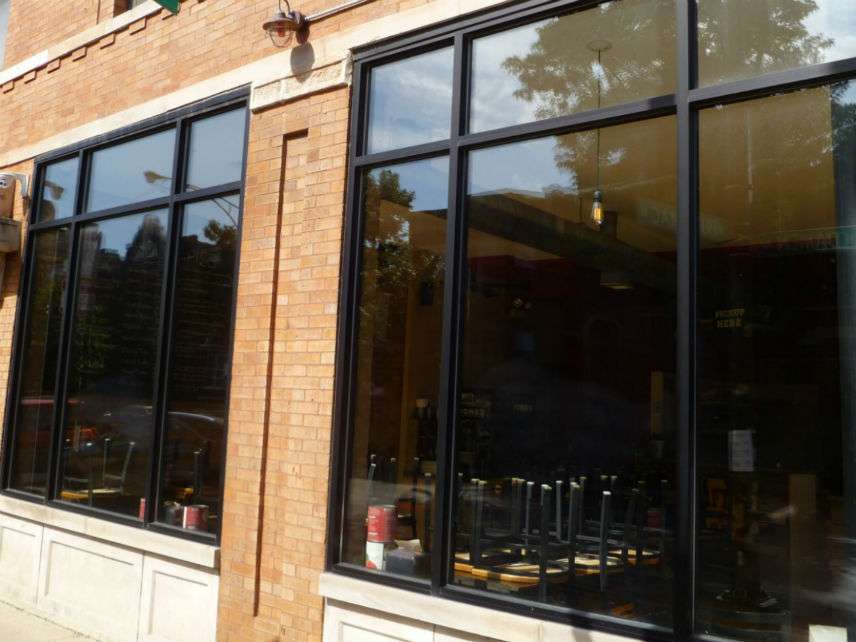Chicago to Businesses: Did Licensed Contractors Hang Those Window Signs?
Classic protection racket enforced by city fines.

Want to put a sign—or even just a sticker—on the window of your Chicago pizzeria? Better get a licensed contractor and a zoning review first, or else expect to pay fines ranging in the thousands of dollars.
Scott Toth, owner of Craft Pizza in the city's Wicker Park neighborhood, learned about this regulation last year when his business was ticketed. He had four vinyl stickers in his business windows, which he put up in 2014 and 2015.
In order to follow the city's rules, any window signs must be installed by a licensed sign contractor (a list of these contractors is conveniently located on the city's website)—even if the sign is just a sticker. Toth tells Reason that this is the classic "Chicago way" in which regulations "force you to use union stuff."
According to Toth, the city's rules regarding signs are rarely enforced, and he only knows of a couple other businesses in his neighborhood that were targeted.
The city's on-premise sign guidelines apply to window signs made of paper, sticker material, vinyl or film that take up more than 25 percent of a window and are in place for more than 60 days. The rules also apply to signs painted on more than 25 percent of a window. These signs are technically required to go through an expensive permitting process in addition to hiring contractors for installation.
For a permit, a business must pay a zoning review fee of $200 and a building department review fee based on the size of the sign. Building department review fees range from $50 for signs between zero and 49 square feet up to $1,000 for a sign over 500 square feet.
Fines for noncompliance range from $350 to $15,000 per sign per day. It is unknown how the city determines the fine amount. The Department of Buildings, which enforces this regulation, did not respond to requests for comment from Reason.
Toth says he was not allowed to represent himself and was forced to hire an attorney to fight the fine. After paying his attorney approximately $1,000, the fine was reduced from $1,000 to around $600 and he agreed to pay. "At some point you've just got to cry uncle," Toth says.
Another restaurant, Dove's Luncheonette, received two violations on two window signs that date back to 2014. According to DNAinfo, the restaurant was able to get the fines waived by applying for permits.
Wicker Dry Cleaners, located next to Craft Pizza, claims that unpermitted signs had been up for 14 years without issue. The painted signs, which read "wedding dress cleaning" and "leather repair," have since been taken down after inspectors threatened the business with a $1,000-per-day fine.
Mimi Simon, a spokesperson for the Department of Buildings justified the regulation in a statement:
"[S]igns under 50 square feet in a single window have a minimal zoning review fee of $50, and if a business is found to be noncompliant, fines are typically not issued if the business can prove compliance with the Chicago Building Code at an Administrative Hearing. … The goal of the Department of Buildings is to work with business owners to bring them into compliance"
But this was not Toth's experience.
"It's such an arcane rule. And it's not like you can look it up somewhere," Toth tells Reason. "I've gone downtown and there is no sign division of the city, it's the building department. And there is not a person you can go to and say 'okay can you sit down and tell me exactly what I need to do or not to'… The general attitude is go hire a sign guy and he'll tell you what you've got to do."
As reported in DNAinfo, 1st Ward Alderman Joe Moreno wants to see a more business-friendly regulation: "the city is punishing small businesses and needs to back off." He is working on an ordinance that would allow window signs "for a nominal fee."
For now, Toth has given up on hanging signs in his business's windows. Since Craft Pizza is located in a more residential area, he is concerned that, thanks to the city, his business will just look like an office building.
Above was an image of the windows before the city stepped in. Below is the current storefront:



Show Comments (78)